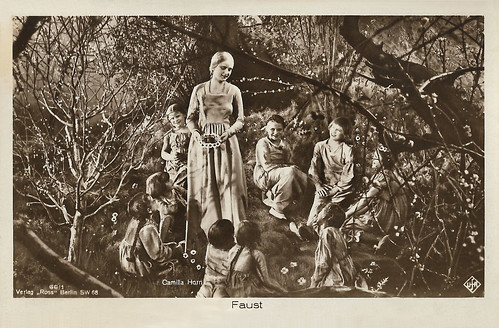
German postcard by Ross Verlag, Berlin, no. 66/1. Photo: Ufa. Camilla Horn in Faust (Friedrich Wilhelm Murnau, 1926).

German postcard by Ross Verlag, no. 62/5. Photo: ParUfaMet / Ufa. Gösta Ekman in Faust (F.W. Murnau, 1926).
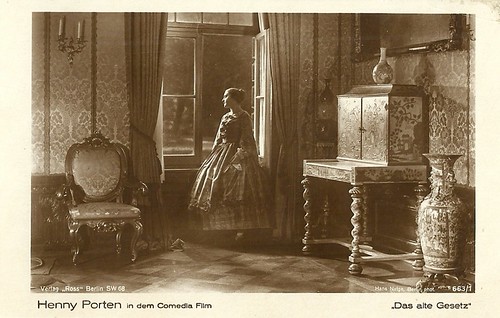
German postcard by Ross Verlag, no. 663/1. Photo: Hans Natge, Berlin / Comedia Film. Henny Porten in Das alte Gesetz (E.A. Dupont, 1923).
Sturdy and blond Henny Porten (1890-1960) was one of Germany's most important and popular film actresses of silent cinema. She became the quintessence of German womanhood, ladylike yet kindhearted and a not a little petit bourgeois. She was also the producer of many of her own films.
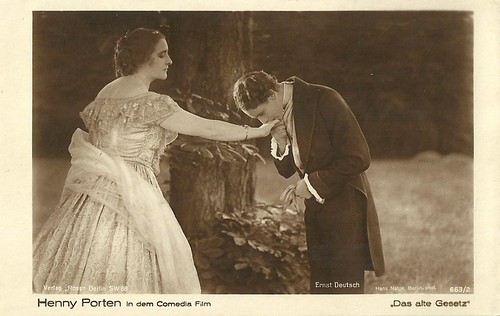
German postcard by Ross Verlag, no. 663/2. Photo: Hans Natge, Berlin / Comedia Film. Henny Porten and Ernst Deutsch in Das alte Gesetz (E.A. Dupont, 1923).

German postcard by Ross Verlag, no. 663/5. Photo: Hans Natge, Berlin. Henny Porten in Das alte Gesetz (E.A. Dupont, 1923).

German postcard by Ross Verlag, Berlin, no. 1272/2, 1927-1928. Photo: Hans Natge.
Conrad Veidt (1893–1943) was the most highly strung and romantically handsome of the German expressionist actors. From 1916 until his death, he appeared in well over 100 films, including such classics as Das Kabinett des Dr. Caligari/Das Cabinet des Dr. Caligari (Robert Wiene, 1920) and Casablanca (Michael Curtiz, 1942).

German postcard by Ross Verlag, Berlin, no. 1273/1, 1927-1928. Photo: Hans Natge.
Hungarian-born film star Lya de Putti (1899-1931) portrayed vamps in German and American silent films.

German postcard by Ross Verlag, no. 1273/2, 1927-1928. Photo: Hans Natge.
Several roles in the realm of cameras, directing and assistant directing
Hans Karl Heinrich Natge was born in Berlin in 1893. Natge was very involved in German silent film production, especially at the Ufa. During the 1920s, he played several roles in the realm of cameras, directing and assistant directing. His filmography on IMDb reports that he has 28 film credits between 1924 and 1949. Nineteen of these credits were for his role as the film’s 'still photographer'.
Natge worked as a still photographer for Friedrich Wilhelm Murnau on his masterpieces Der letzte Mann (Friedrich Wilhelm Murnau, 1924) and Faust (Friedrich Wilhelm Murnau, 1926). Besides etheric portraits of the young Camilla Horn who played Gretchen in Faust, Natge also made photo portraits of director Murnau himself.
For another great Weimar film-maker, Ewald Andre Dupont, he made stills for Das alte Gesetz (E.A. Dupont, 1923) with Henny Porten and the classic Moulin Rouge (Ewald André Dupont, 1928). Dupont took almost a year to make Moulin Rouge at a production cost of $500,000, a huge amount for 1928. Natge made portraits of the French leading man of the film, Jean Bradin. He also made the still photographs for another film with German diva Henny Porten, Liebe im Kuhstall/Love in the Cowshed (Carl Froelich, 1928).
In the early 1930s, Hans Natge also made a few films as an assistant director or co-director. These included Es kommt alle Tage vor... (Hans Natge, Adolf Trotz, 1930) starring Walter Rilla and Das Lied der Schwarzen Berge/Fantom Durmitora/The Song of the Black Mountains (K. Breiness, Hans Natge, 1933) starring Ita Rina.
As a still photographer, Hans Natge steadily worked during the 1930s and early 1940s on such light entertainment films as Ein Lied, ein Kuß, ein Mädel/A Song, A Kiss, A Girl (Géza von Bolváry, 1930) starring Marta Eggerth and Die göttliche Jette/The divine Jetta (Erich Waschneck, 1937) starring Grethe Weiser. According to IMDb, his final film was Willi Forst's Wiener Mädeln/Viennese Girls (1949). The film was begun in 1944, but not completed until 1949.
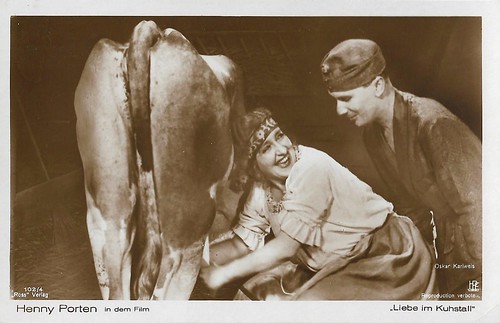
German postcard by Ross Verlag, no. 102/4. Photo: Henny Porten Freuhlich-Produktion. Henny Porten and Oskar Karlweiss in Liebe im Kuhstall/Love in the Cowshed (Carl Froelich, 1928).

German postcard by Ross Verlag, no. 102/5. Photo: Henny Porten Freuhlich-Produktion. Henny Porten and Otto Wallburg in Liebe im Kuhstall/Love in the Cowshed (Carl Froelich, 1928).

German postcard by Ross Verlag, no. 1274/5, 1927-1928. Photo: Hans Natge / Ufa.
Gösta Ekman (1890–1938) was the first real star of the Swedish theatre. His boyish good looks attracted both sexes, helping to create a massive cult following and elevating him to the status of a living legend. Combined with a beautiful voice and a powerful stage and screen presence, Ekman was able to captivate his audiences.
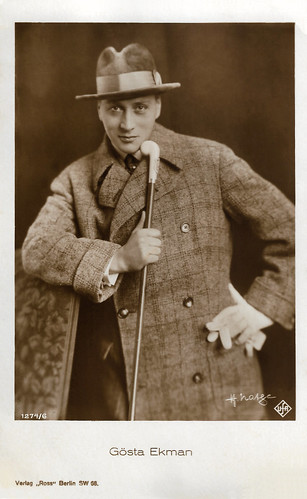
German postcard by Ross Verlag, Berlin, no. 1274/6. Photo: Hans Natge / Ufa.
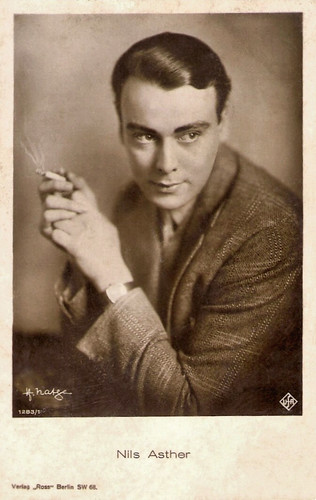
German Postcard by Ross Verlag, Berlin, no. 1283/1, 1927-1928. Photo: Hans Natge / Ufa.
Good-looking Swedish actor Nils Asther (1897-1981) was an intense star of silent European cinema. In Hollywood, he was the leading man of stars like Pola Negri, Greta Garbo and Marion Davies and was labelled ‘the male Greta Garbo’.

German postcard by Ross Verlag, no. 1498/2. Photo: Hans Natge / Ufa. Camilla Horn in Faust (Friedrich Wilhelm Murnau, 1926).
Ethereally blonde Camilla Horn (1903-1996) was a German dancer and film star. Her breakthrough role was Gretchen in the silent film classic Faust (Friedrich Wilhelm Murnau, 1926). She also starred in some Hollywood films of the late 1920s and in a few British and Italian productions.

German postcard by Ross Verlag, no. 1498/3. Photo Hans Natge / Ufa. Camilla Horn in Faust (Friedrich Wilhelm Murnau, 1926).
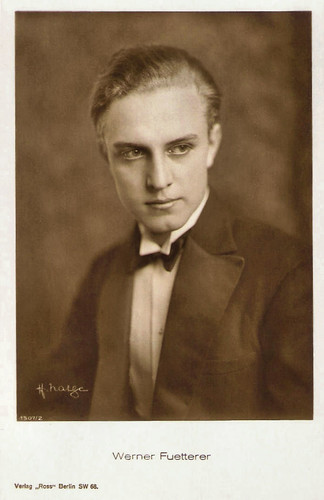
German postcard by Ross Verlag, Berlin, no. 1507/2, 1927-1928. Photo: Hans Natge.
At the age of 18, German actor Werner Fuetterer (1907-1991) was discovered to play the young lover in a series of silent films. For more than four decades he went on to work as a supporting actor in nearly 100 films.
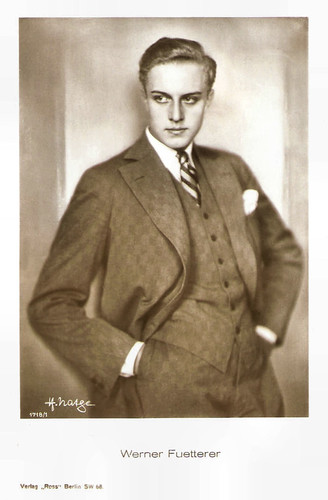
German postcard by Ross Verlag, Berlin, no. 1718/1, 1927-1928. Photo: Hans Natge.

German postcard by Ross Verlag, Berlin, no. 1924/1, 1927-1928. Photo: Hans Natge.
Very few personal facts are known about French actor Jean Bradin (1899-1969). Yet, he was a prolific film actor from the early 1920s onward, acting first in French and also afterwards in German and British films, including Hitchcock's Champagne (1928) and Dupont's Moulin Rouge (1928).

German postcard by Ross Verlag, no. 3305/1, 1928-1929. Photo: Hans Natge.
Handsome actor Werner Pittschau (1902-1928) was the promising Jeune premier of the silent Austrian cinema. Sadly he was killed in a road accident at the age of 26.

German postcard by Ross Verlag no. 3961/1, 1928-1929. Photo: Atelier Natge, Berlin.
British gentleman actor Jack Trevor (1890-1976) had a great career in the German and Austrian silent cinema of the 1920s but during World War II he was forced by the Nazis to appear in Anti-English propaganda films.

German postcard by Ross Verlag, no. 3961/2, 1928-1929. Photo: Atelier Natge, Berlin.

Austrian postcard by Iris Verlag, no. 5472. Photo: Hans Natge, Berlin.
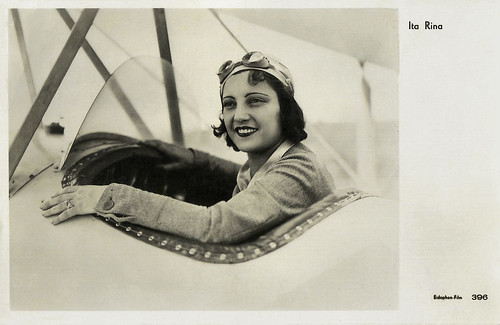
Dutch postcard by JosPe, no. 396. Photo: Eidophon-Film. Ita Rina in Das Lied der Schwarzen Berge/Fantom Durmitora/The Song of the Black Mountains (K. Breiness, Hans Natge, 1933).
Yugoslav film actress and beauty queen Ita Rina (1907-1979) was one of the major film stars in Germany and Czechoslovakia in the late 1920s and early 1930s.
Sources: The Cabinet Card Gallery and IMDb.
No comments:
Post a Comment